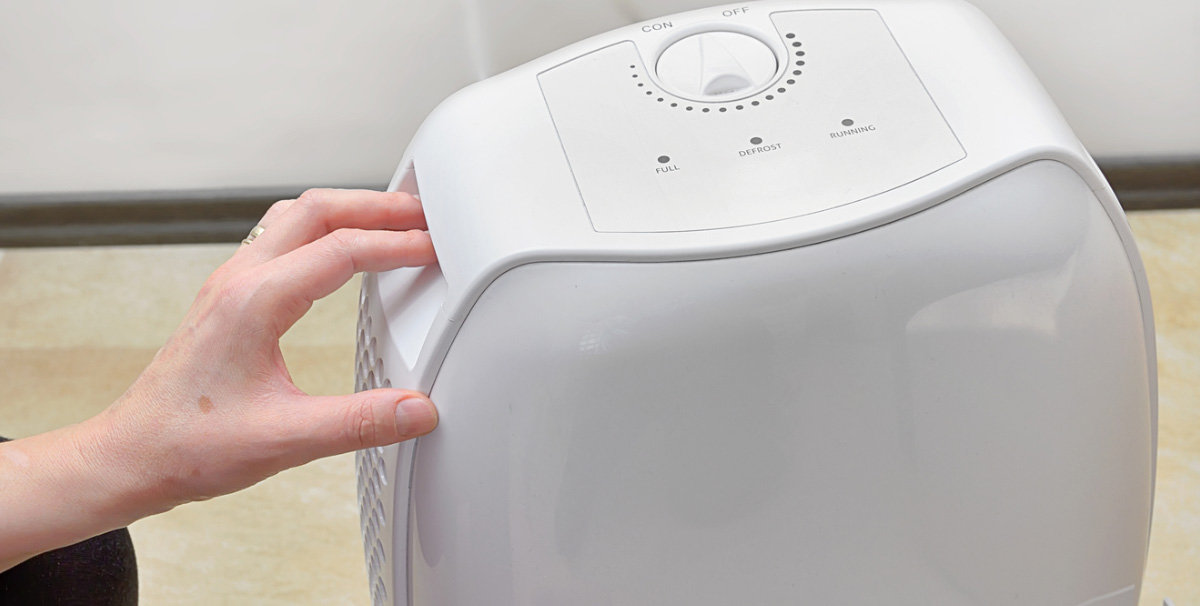If you live in a humid climate, you’re likely familiar with the benefits of a dehumidifier. These handy appliances can help reduce moisture in the air, prevent mold growth, and create a more comfortable living environment.
But when should you turn off your dehumidifier?
You should turn off a dehumidifier when the humidity level is below 30-50%. However, some dehumidifiers have an automatic shut-off feature that activates when it reaches a specific humidity level. Additionally, it’s essential to turn off the dehumidifier if there are any signs of damage or malfunction.
In this blog post, I’ll take a closer look at when you should turn off your dehumidifier, so you can get the most out of this essential appliance without wasting energy or causing damage to your home.
What is a Dehumidifier, and How Does It Work?
A dehumidifier is an electronic device that removes excess moisture from the air in a room or enclosed space. It is typically used to regulate the humidity level in indoor spaces, which can help prevent mold and mildew growth, reduce allergens, and improve air quality.
Dehumidifiers draw in humid air through a fan and pass it over a cold coil. As the air passes over the cold coil, the moisture in the air condenses into water droplets which then collect in a container or drain hose. The now-dry air is then reheated and released back into the room.
The condensation process works because cold air cannot hold as much moisture as warm air. By cooling the air, the dehumidifier reduces the amount of water vapor it can hold, causing the excess moisture to condense.
When Should You Not Use a Dehumidifier?
There are certain situations when using a dehumidifier is not recommended. For example, in cold environments with a temperature below 60°F, using a dehumidifier can cause the coils to freeze, damaging the unit.
Additionally, in areas with high humidity levels due to outdoor air, such as near a swamp or marsh, using a dehumidifier can cause the unit to work excessively and ultimately fail.
Similarly, when there is a significant water leak or flood, using a dehumidifier can spread moisture and further damage the surrounding materials.
In such cases, addressing the underlying issue is better than using a dehumidifier as a solution.
Is It Okay to Leave a Dehumidifier on All Day?
It is generally okay to leave a dehumidifier on all day if you follow the manufacturer’s instructions and take some basic safety precautions.
Dehumidifiers are designed to remove excess moisture from the air, which can help prevent mold growth and reduce humidity-related health issues.
Many modern dehumidifiers also have automatic shut-off features and energy-saving settings, which can help reduce operating costs.
How Long Does It Take for a Dehumidifier to Dry Out a Room?
Typically, it can take anywhere from a couple of hours to a few days for a dehumidifier to dry out a room, depending on factors such as the room size and level of humidity.
For instance, a small room with moderate humidity could take about 12-24 hours to completely dry out using an appropriately sized and effective dehumidifier.
Conversely, larger or more humid rooms may take a longer period, ranging from a few days to a week.
Can You Dehumidify Too Much?
It is possible to dehumidify too much. While it is important to maintain a healthy humidity level in your home, excessively low humidity levels can also negatively affect your health and your home’s health.
When Is the Best Time of Year to Use a Dehumidifier?
The best time of year to use a dehumidifier is typically in the spring, summer, and early fall when humidity levels are at their highest.
During these months, the air tends to be more humid due to warmer temperatures and increased moisture in the air.
A dehumidifier can help to remove excess moisture from the air, reducing the risk of mold and mildew growth, musty odors, and other issues that high humidity levels can cause.
Should You Use a Dehumidifier in Your Basement Gym During the Winter?
Using a dehumidifier in your basement gym during the winter can be beneficial, especially if your basement tends to be damp or humid.
When the temperature drops outside, the air in your basement gym can become cooler and cause moisture to condense, leading to increased humidity levels.
How Do You Properly Maintain and Operate a Dehumidifier?
To properly maintain and operate a dehumidifier, there are a few key things to keep in mind.
- First, cleaning or replacing the air filter regularly is essential to ensure the unit works effectively.
- It would help if you emptied the water tank frequently to prevent overflow and damage to the unit. Keeping the dehumidifier in a well-ventilated area for proper air circulation is also a good idea.
- Finally, follow the manufacturer’s instructions for operation, including setting the appropriate humidity level and using the unit only in the recommended room size.
What Are the Costs of Running a Dehumidifier 24/7?
On average, running a dehumidifier costs $0.03 to $0.16 per hour with an average power consumption of 300 to 700 watts. Running a dehumidifier 24/7 can cost between $2.16 to $11.52 per day or $64.80 to $345.60 monthly.
However, it’s worth noting that newer models of dehumidifiers are designed to be more energy-efficient so the actual cost may vary based on the model and usage.
Why Might a Dehumidifier Not Shut Off Even When the Desired Humidity Level Is Reached?
One possibility is that the humidistat, which is the device that senses the humidity in the air and controls the dehumidifier’s operation, needs to be fixed or calibrated correctly.
In this case, the humidistat may not accurately sense the humidity level and could continue to run the dehumidifier even when it’s not necessary.
Another possibility is that the dehumidifier’s condenser coils are dirty or blocked, which can reduce the unit’s efficiency and cause it to run longer than necessary to achieve the desired humidity level.
Finally, it’s possible that the dehumidifier is simply undersized for the space it’s in, in which case it may not be able to keep up with the moisture in the air even when it’s constantly running.
Are Dehumidifiers Better in Winter or Summer?
Dehumidifiers are generally more effective in the summer when the humidity is higher. During the winter, indoor humidity levels tend to be lower due to the colder temperatures outside.
However, there are situations where a dehumidifier may be beneficial in the winter, such as in a damp basement or if the house is tightly sealed, leading to moisture buildup from activities like cooking and showering.
It is important to monitor the humidity levels in your home year-round and use a dehumidifier as needed to maintain a healthy and comfortable environment.
How do you set up and use your dehumidifier for optimal results?
- Determine the appropriate size: Before purchasing a dehumidifier, it’s important to determine the appropriate size for the space you want to dehumidify. Dehumidifiers are rated based on the amount of moisture they can remove per day, so choose a model that can handle the square footage of your space.
- Choose the right location: The best location for your dehumidifier is typically in a central location in the room, away from walls and furniture. This will allow it to circulate air throughout the space and remove moisture more effectively.
- Adjust the settings: Once you’ve plugged in your dehumidifier and positioned it in the right spot, it’s time to adjust the settings. Most models will have adjustable humidity levels, so set it to your desired level of humidity (usually between 30-50%). You may also be able to adjust the fan speed and timer settings.
- Empty the water tank: Dehumidifiers collect moisture in a water tank, which will need to be emptied periodically. Make sure to check the water tank regularly and empty it when it’s full.
- Clean the filter: Dehumidifiers have filters that will collect dust and debris over time. Be sure to clean the filter regularly to keep your unit running efficiently.
- Maintain proper ventilation: To get the most out of your dehumidifier, it’s important to maintain proper ventilation in your space. This means opening windows and doors, using exhaust fans, and avoiding blocking air vents.
By following these steps, you can set up and use your dehumidifier for optimal results and effectively control the humidity levels in your space.
Conclusion
So there you have it, everything that you need to know about how to build a home gym in your shed.
A shed gym can be an excellent option for people who want to get in shape but don’t have the time or money to go to a traditional gym, and they are convenient, affordable, and customizable to your own needs.
Setting up a gym shed will increase your fitness routine without breaking the bank with careful planning ahead of time. And best of all, you can use them in any weather condition! So if you’re looking for an easy way to get in shape, a shed gym is the way to go.

